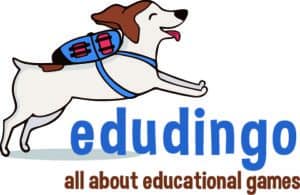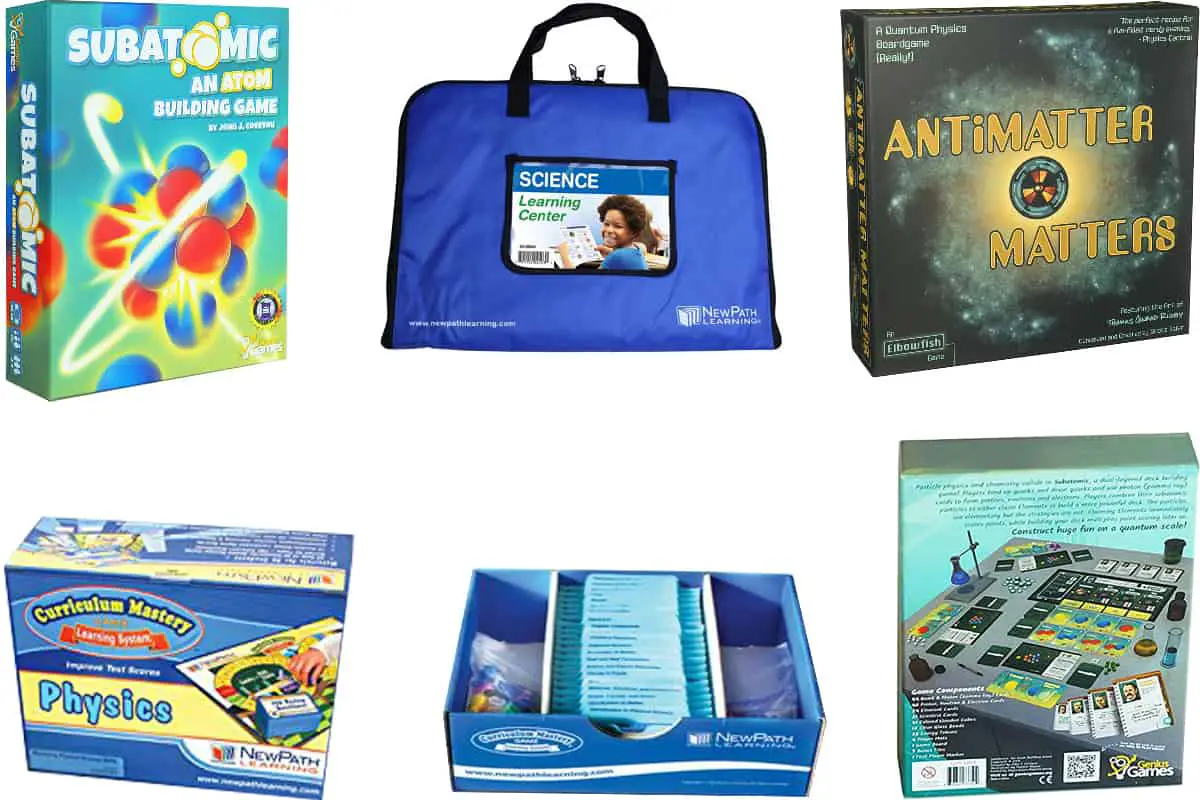This post contains affiliate links.
Physics board games? I love that. Physics was my preferred subject back when I was in High School & College, and I hope those physics board games I am going to show you will make physics shine with students that might not like physics as much as I do.
What are the available physics board games? There are:
- 3 classical physics learning centers by Newpath Learning for primary school (Newton’s Laws of Motion), middle school, and High school.
- 3 physics themed board games about atom physics (“Subatomic”, “Antimatter matters”) and “Spin physics”
Physics Board Games Comparison Table
| Game | Grades | Type | For | Players | Price | Rating |
|---|---|---|---|---|---|---|
| Newton’s Laws of Motion | Primary School | Learning center | Teachers | 2-4 | $$$ | ★★★☆☆ |
| Middle School Physical Science | Middle School | Learning center | Teachers | 2-4 | $$$$$ | ★★★☆☆ |
| Physics Review, High School | High School | Learning center | Teachers | 2-4 | $$$$ | ★★★☆☆ |
| Subatomic | University | Deck building | Families | 2‑4 | $$$ | ★★★★☆ |
| Antimatter Matters | University | Race game | Families | 2‑6 | $$$$ | ★★★☆☆ |
| Spin Physics | University | Strategy game | Professors | 2 | €€ | ★★★★☆ |
Classical Physics Board Games
Newton’s Laws of Motion Learning Center Game (Newpath Learning)
★★★☆☆
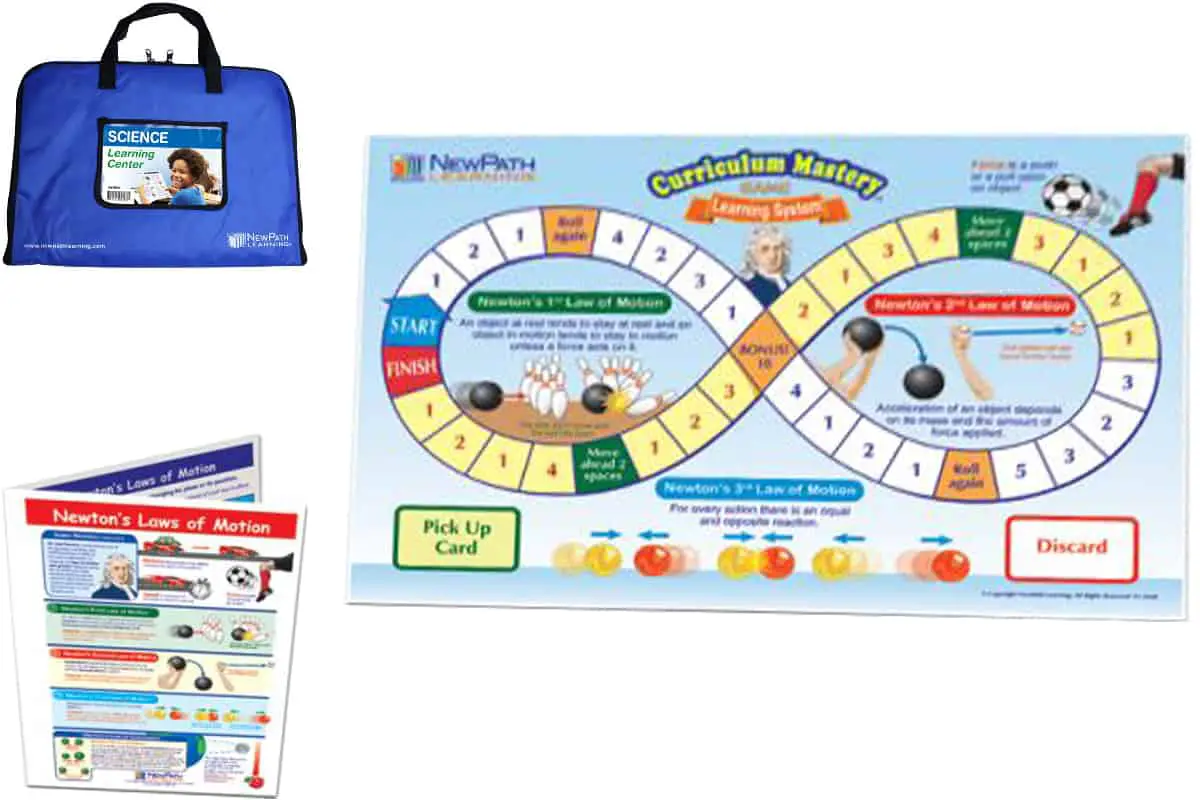
2-4 players | Grade 3-5 | For schools | Price $$$
Newton’s Laws of Motion Learning Center Game presents the laws of motion in well-illustrated explanations as well as a board game with its set of question cards. As usual for Newpath Learning games, it is an excellent complement to the physics class course. It includes up to 4 players:
- 30 illustrated question cards with the answer on the back
- A Game board
- 4 learning guides
- A storage pouch
Middle School Physical Science Curriculum Mastery Game (Newpath Learning) – Class Pack Edition
★★★☆☆
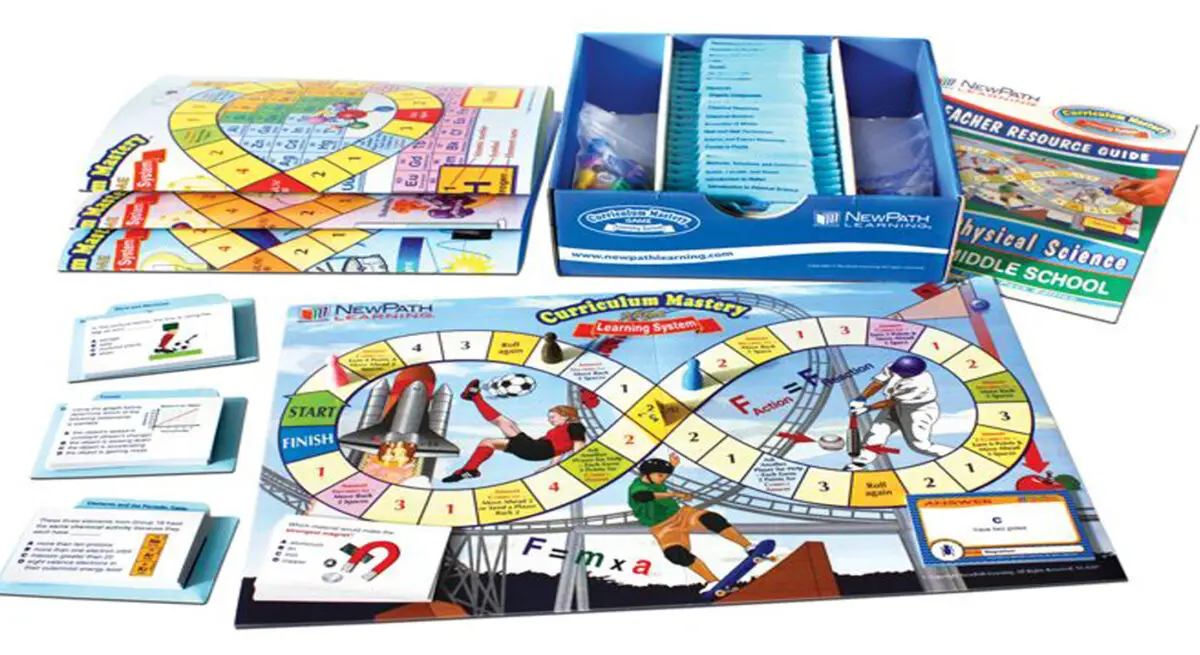
2-4 players | Grade 5-9 | For schools | Price $$$$$
I recommend NewPath Learning’s Middle School Physical Science Curriculum Mastery Game . It includes 12 double-sided game boards (with meeples and dice) and 750 review question cards (multiple choice questions with the answer on the back) divided into 30 topics that address a wide range of Middle School physics and chemistry curriculum subjects for grades 5 to 9:
. It includes 12 double-sided game boards (with meeples and dice) and 750 review question cards (multiple choice questions with the answer on the back) divided into 30 topics that address a wide range of Middle School physics and chemistry curriculum subjects for grades 5 to 9:
- States of matter, solutions, and compounds
- Motion, forces, work, energy, and heat
- Atoms, periodic table, chemical bonds, and reactions
- Acids, bases, salts, organic compounds, practical chemistry
- Electricity, magnetism, electromagnetism
- Waves, sound, light, optics
- Practical technology
The review cards are organized by levels, each corresponding to a grade. A school can buy one set and share it among school teachers that teach classes from grade 5 to 8. The product includes a teacher guide.
The race board game principle used is not very original (and not very dynamic). Still, it makes sense in a classroom setting to create learning centers that are adaptable to the currently learned subjects (or for later review).
NewPath Learning also proposes Science Curriculum Mastery Game Packs by grade – you might consider this alternative if instead of buying a pack for the school, you buy one for a specific classroom grade. Each pack also has 750 cards that cover the science curriculum for that grade. The concept makes a lot of sense for a classroom, as the game covers a wide range of topics studied for that grade.
Physics Review Curriculum Mastery Game, High School (Newpath Learning)
★★★☆☆
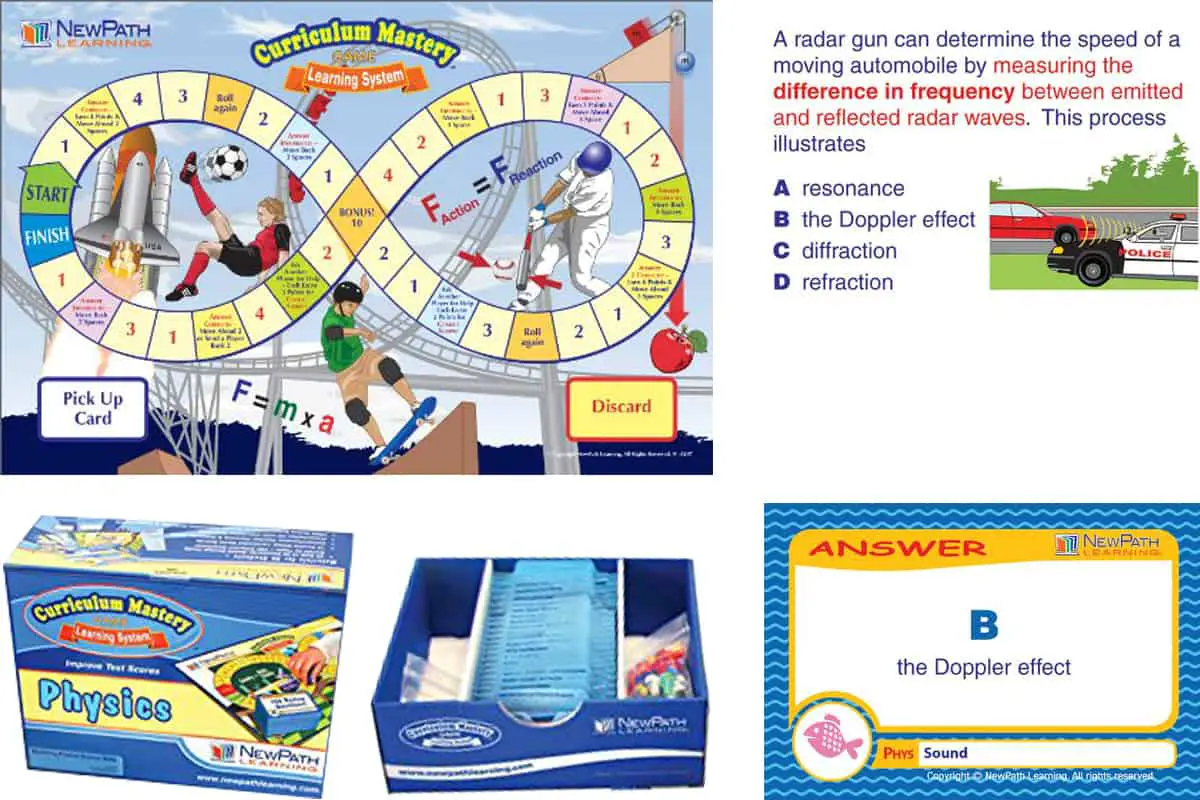
2-4 players | Grade 9-12 | For Schools | Price $$$$$
Newpath Learning’s Physics Review Curriculum Mastery Game for High School is the same principle as the Middle School’s one, covering the following topics:
is the same principle as the Middle School’s one, covering the following topics:
- Laws of Motion, Forces, Universal Gravitation
- Work & Energy, Momentum & Collisions
- Properties of Matter, Heat & Thermodynamics
- Mechanics
- Vibrations & Waves, Sound, Light, Optics
- Electricity, Electric Circuits & Electronics
- Magnetism, Electromagnetism
- Atomic & Nuclear Physics
- Measurements, Investigations, Scientific Method
Just one caveat: there are quite a few incorrect answers on the cards. You should correct the back of the faulty cards by hand with a “Tipp-ex,” for example, if you do not want your students to be misled (for example, a card states that the mass of the same object changes according to the planet, while it is the weight, not the mass that changes, of course).
I recommend leveraging these errors. Turn them to your advantage and your student’s advantage: count (and record) the incorrect answers and make it a challenge for your students to find them. They will be far more attentive to the precise contents of the questions and answers. In the end, it will help them memorize the contents better as well and develop their critical thinking, something that is essential nowadays where you read so many media articles that are scientifically inaccurate. This approach allows you also to use the provided digital version.
Atom Physics (Building Atoms) Board Games
Subatomic (Genius Games)
★★★★☆
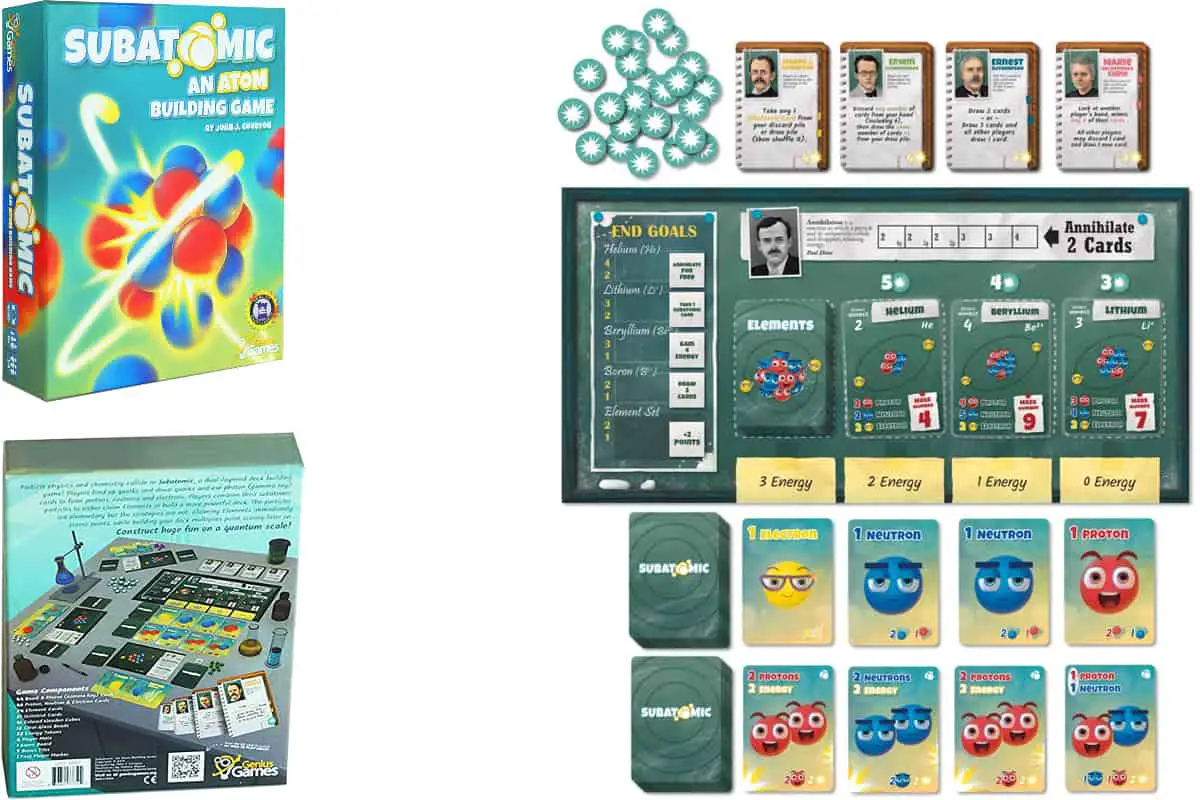
2-4 players | Age 10+ | Price $$$ | For families
Subatomic is a well-designed board game. It is a (simple) “Deck Building” game with some original aspects in the game mechanics that make it enjoyable to play for board game enthusiasts.
is a well-designed board game. It is a (simple) “Deck Building” game with some original aspects in the game mechanics that make it enjoyable to play for board game enthusiasts.
As Middle and High School students like board games, many of them will be more than happy to play it. The game lasts 40 to 60 minutes, which is pretty long, but it is still OK if played at home (but some players might be a bit bored because of the length).
I also have to mention that it is well built: lovely pieces, nice graphic design, not too severe and not too silly.
If your objective is to play a good board game with a scientific theme, Subatomic is for you. Here is a great review video by Tom Vasel (he highly recommends it) which will detail the mechanics of the game for you if you are interested in knowing more:
I will differ from his recommendation though.
If you want a “motivational game” to present some physics concepts to someone fearful of physics, Subatomic does this job well. If your kids love physics and want a physics themed game, it is also a perfect game.
But if you want the players to learn about particles & atoms while playing the game, Subatomic will disappoint you. It is not a learning game, but a “real board game” (you are slightly exposed to some scientific notions). The notions in the game are quite basic: (1) which quarks to combine to build atomic particles and (2) how to build Helium, Berylium, Lithium, and Boron. Nothing about other atoms, or the roles atomic particles play in the characteristics of the atom, quantum mechanics, how atoms behave. Overall there is too little to learn there, in my opinion.
Antimatter Matters (Elbowfish)
★★★☆☆
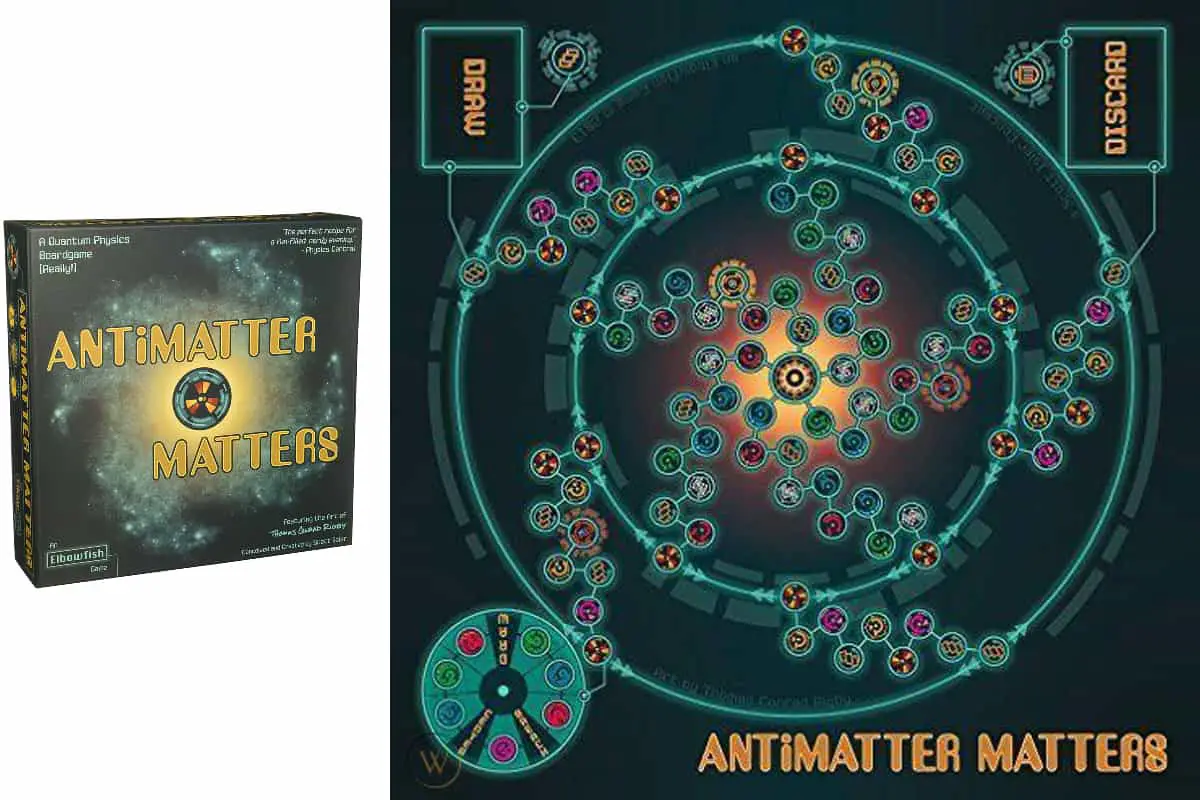
2-6 players | Age 11+ | Price $$$$ | For families | Author: Scott Isler
Antimatter Matters is similar to Subatomic in that the objectives of the players is to build atoms from elementary particles. Quite similarly, it is quite a success visually with a very good graphic design, and very good game pieces with professional quality.
is similar to Subatomic in that the objectives of the players is to build atoms from elementary particles. Quite similarly, it is quite a success visually with a very good graphic design, and very good game pieces with professional quality.
From the gaming point of view, “Antimatter matters” is not as good in my opinion as Subatomic though, as “Antimatter Matters” has a lot of pieces, takes more time to explain and learn, and is much less dynamic in the gameplay (a race game without many strategies, which would be fine for a pure learning game, but like with “Subatomic” this is not really a learning game but rather a board game with a physics theme).
You do have the advantage that you have more different rules, and that in principle, you can build more atoms (depending on the rule you chose). But it does not matter as the game is not really intended to learn physics but rather to make physics more palatable for people who do not like it in the first place or to cater to kids that love physics and would enjoy a physics themed game.
Quantum Physics Board Games
Spin Physics (Alexander Hartmann)
★★★★☆
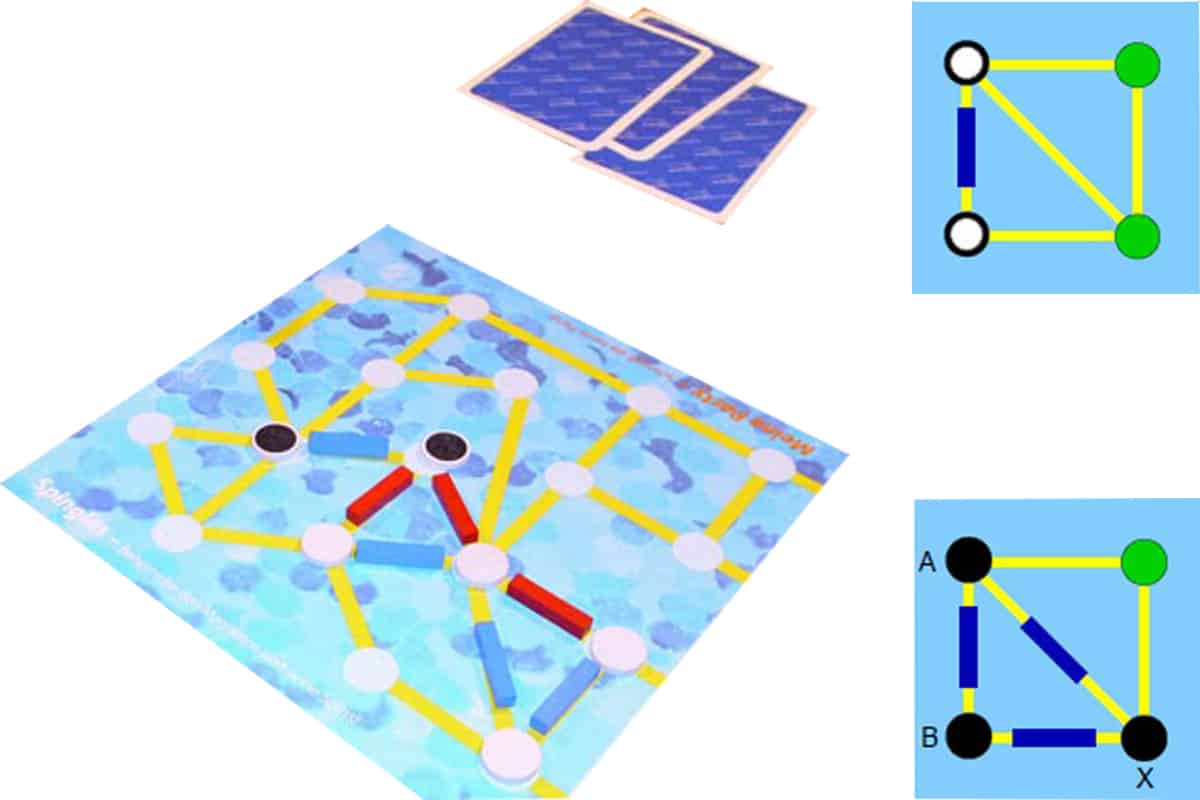
2 players | Age 20+ | Price €€ | For professors | Author: Alexander Hartmann, University of Oldenburg, Germany
Spin Physics is a strategy game inspired by spin glass physics – a very specialized topic relevant for University students only, but which is a very interesting topic of magnetism. I have to admit that I am biased towards magnetism theory, as my grandfather (Louis Néel) was a renowned magnetism physicist. Topics around magnetism are always fascinating for me.
is a strategy game inspired by spin glass physics – a very specialized topic relevant for University students only, but which is a very interesting topic of magnetism. I have to admit that I am biased towards magnetism theory, as my grandfather (Louis Néel) was a renowned magnetism physicist. Topics around magnetism are always fascinating for me.
Having said that, the fact is “Spin Physics” is a good and yet simple strategy game. Each player has a color (white or black) and pieces of that color that represent a particle with a spin. They also have two types of bonds that they can place between pieces on the board: “ferromagnetic” bonds (connecting two same spin atoms) and “antiferromagnetic” bonds that connect opposite spin atoms.
The strategy lies in the fact that by placing strategically your bonds you can force your opponent’s atoms to change their spin in your favor (you win in the end if you have more atoms of your spin).
You can download “Spin Physics” as a printable on the following page of the University of Cornell or directly download the PDF here
or directly download the PDF here . Another possibility is to email the university of Oldenburg to ship you a professional version of the game for 14.50 euros (a bargain) plus shipping costs at bisverlag@uni-oldenburg.de
. Another possibility is to email the university of Oldenburg to ship you a professional version of the game for 14.50 euros (a bargain) plus shipping costs at bisverlag@uni-oldenburg.de . If you want a more detailed description of the context of the game, you can also read this excellent “Physics central” blog post
. If you want a more detailed description of the context of the game, you can also read this excellent “Physics central” blog post .
.
Edudingo.com is a participant in the Amazon Services LLC Associates Program, an affiliate advertising program designed to provide a means for sites to earn advertising fees by advertising and linking to Amazon.com. We also participate in other affiliate programs which compensate us for referring traffic.
